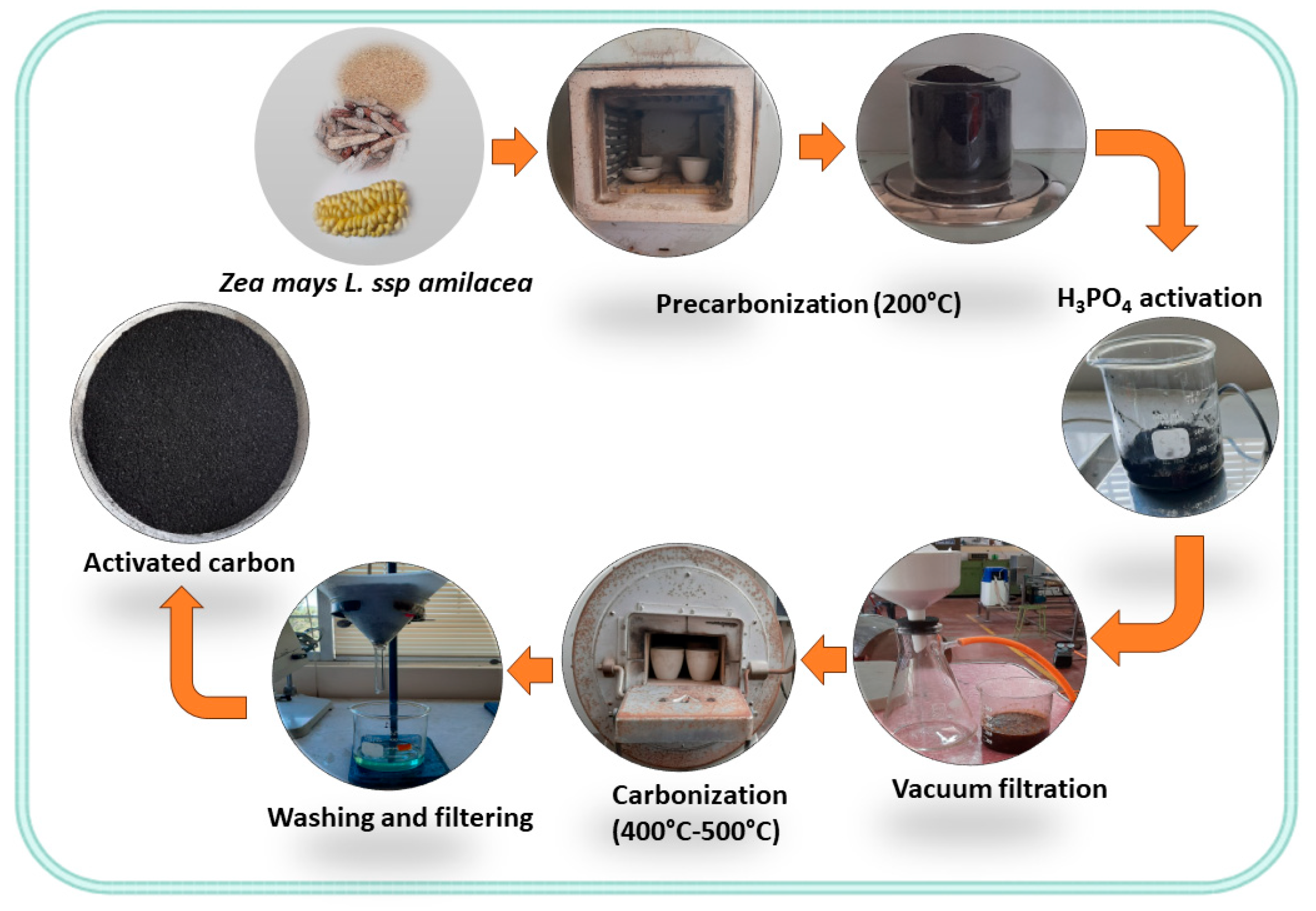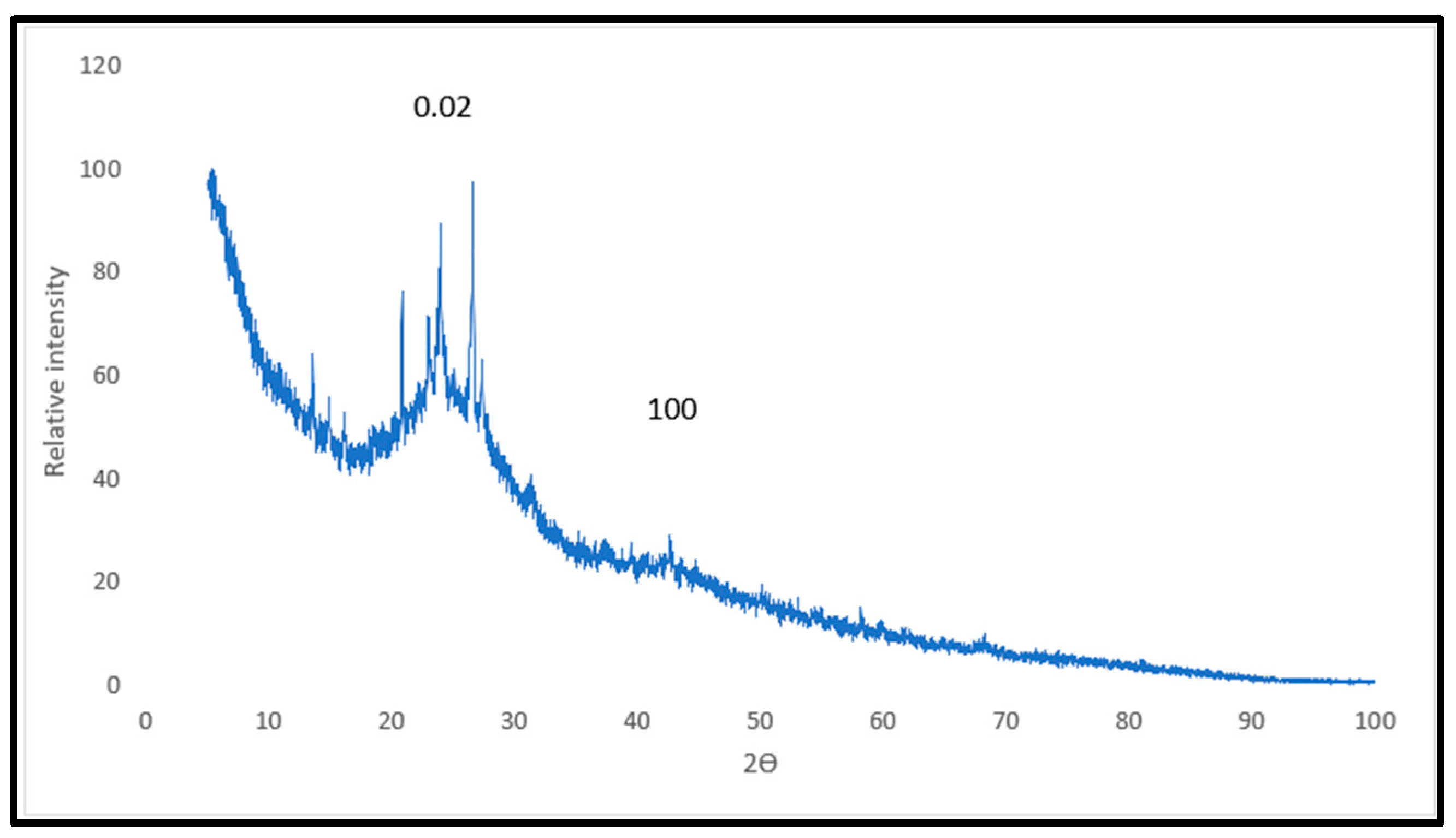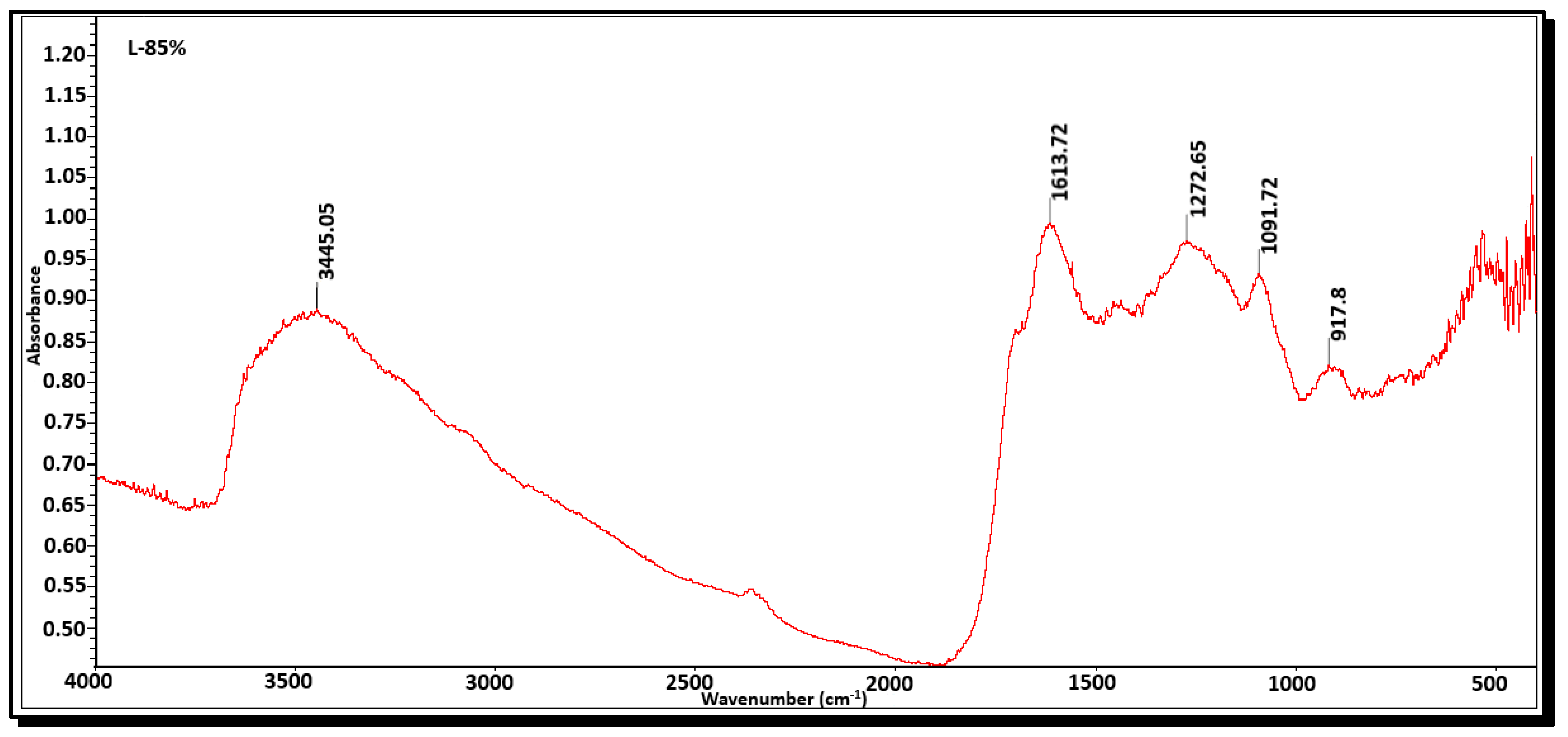Enhancing Dye Removal Efficiency Through Sustainable Adsorbent Production from Corncobs (Zea mays L. ssp. amilacea)
Abstract
1. Introduction
2. Materials and Methods
2.1. Reagents
2.2. Organic Samples
2.3. Synthesis of Activated Carbon
2.4. Characterization of Activated Carbon
- Moisture Determination
- Ash Determination
- Apparent Density Determination
- FTIR Analysis
- X-Ray Diffraction Analysis (XRD)
- Surface Area Analysis
- Determination of Dye Adsorption Capacity
3. Results and Discussion
3.1. Characterization of the Raw Material
3.2. Physical Characterization and Yield of Activated Carbons Synthesized from Corncobs by Chemical Activation with H3PO4
3.3. Dye Adsorption Capacity
3.4. Influence of Process Parameters in the Synthesis of Activated Corncob Carbons on the Adsorption Capacity of Methylene Blue Dye
3.5. BET Analysis
3.6. X-Ray Diffraction Analysis
3.7. FTIR Analysis
4. Conclusions
Author Contributions
Funding
Data Availability Statement
Acknowledgments
Conflicts of Interest
References
- Alam, S.; Ilyas, M.; Ullah, S.; Rahman, N.U.; Zahoor, M.; Umar, M.N.; Ullah, R. Fabrication of Magnetic Activated Carbon from Corn-Cob Biomass for the Removal of Acidic Dyes from Wastewater. Desalin. Water Treat. 2024, 317, 100049. [Google Scholar] [CrossRef]
- Ho, S. Removal of Dyes from Wastewater by Adsorption onto Activated Carbon: Mini Review. J. Geosci. Environ. Prot. 2020, 8, 120–131. [Google Scholar] [CrossRef]
- Jaafar, M.T. UV-A Activated ZnO Mediated Photocatalytic Decolorization of Nigrosine (Acid Black 2) Dye in Aqueous Solution. J. Geosci. Environ. Prot. 2017, 5, 138–147. [Google Scholar] [CrossRef]
- Piaskowski, K.; Świderska-Dąbrowska, R.; Zarzycki, P.K. Dye Removal from Water and Wastewater Using Various Physical, Chemical, and Biological Processes. J. AOAC Int. 2018, 101, 1371–1384. [Google Scholar] [CrossRef]
- Ardila-Leal, L.D.; Poutou-Piñales, R.A.; Pedroza-Rodríguez, A.M.; Quevedo-Hidalgo, B.E. A Brief History of Colour, the Environmental Impact of Synthetic Dyes and Removal by Using Laccases. Molecules 2021, 26, 3813. [Google Scholar] [CrossRef]
- Bedin, K.C.; Souza, I.P.A.F.; Cazetta, A.L.; Spessato, L.; Ronix, A.; Almeida, V.C. CO2-Spherical Activated Carbon as a New Adsorbent for Methylene Blue Removal: Kinetic, Equilibrium and Thermodynamic Studies. J. Mol. Liq. 2018, 269, 132–139. [Google Scholar] [CrossRef]
- Kheddo, A.; Rhyman, L.; Elzagheid, M.I.; Jeetah, P.; Ramasami, P. Adsorption of Synthetic Dyed Wastewater Using Activated Carbon from Rice Husk. SN Appl. Sci. 2020, 2, 2170. [Google Scholar] [CrossRef]
- Ramasundaram, S.; Manikandan, V.; Vijayalakshmi, P.; Devanesan, S.; Salah, M.B.; Ramesh Babu, A.C.; Priyadharsan, A.; Oh, T.H.; Ragupathy, S. Synthesis and Investigation on Synergetic Effect of Activated Carbon Loaded Silver Nanoparticles with Enhanced Photocatalytic and Antibacterial Activities. Environ. Res. 2023, 233, 116431. [Google Scholar] [CrossRef]
- Dimbo, D.; Abewaa, M.; Adino, E.; Mengistu, A.; Takele, T.; Oro, A.; Rangaraju, M. Methylene Blue Adsorption from Aqueous Solution Using Activated Carbon of Spathodea Campanulata. Results Eng. 2024, 21, 101910. [Google Scholar] [CrossRef]
- Lewoyehu, M. Comprehensive Review on Synthesis and Application of Activated Carbon from Agricultural Residues for the Remediation of Venomous Pollutants in Wastewater. J. Anal. Appl. Pyrolysis 2021, 159, 105279. [Google Scholar] [CrossRef]
- Kumaravel, S.; Geetha, M.; Niyitanga, T.; Kumar, D.S.; Al-Ansari, M.M.; Mythili, R.; Suganthi, S.; Guganathan, L.; Murugan, A.; Ragupathy, S. Preparation and Characterization of Activated Carbon from Corn Cob by Chemical Activation and Their Adsorption of Brilliant Green Dye from Wastewater. Process Saf. Environ. Prot. 2024, 188, 1338–1345. [Google Scholar] [CrossRef]
- Shahcheragh, S.K.; Bagheri Mohagheghi, M.M.; Shirpay, A. Effect of Physical and Chemical Activation Methods on the Structure, Optical Absorbance, Band Gap and Urbach Energy of Porous Activated Carbon. SN Appl. Sci. 2023, 5, 313. [Google Scholar] [CrossRef]
- Chikri, R.; Elhadiri, N.; Benchanaa, M.; El Maguana, Y. Efficiency of Sawdust as Low-Cost Adsorbent for Dyes Removal. J. Chem. 2020, 2020, 8813420. [Google Scholar] [CrossRef]
- Fofana, A.; Yao Yobouet, A.; Daouda, K.; Eric-Simon Zran, V.; Kone, H.; Verdier Abouo, N.; Joel Boro-Bi, T.; Emmanuel Assidjo, N. Optimization of congo red dye adsorption with activated carbon from the cob of corn (Zea mays L.) By experimental plans. Int. J. Adv. Res. 2022, 10, 216–225. [Google Scholar] [CrossRef]
- Jawad, A.H.; Bardhan, M.; Islam, M.A.; Islam, M.A.; Syed-Hassan, S.S.A.; Surip, S.N.; ALOthman, Z.A.; Khan, M.R. Insights into the Modeling, Characterization and Adsorption Performance of Mesoporous Activated Carbon from Corn Cob Residue via Microwave-Assisted H3PO4 Activation. Surf. Interfaces 2020, 21, 100688. [Google Scholar] [CrossRef]
- Siipola, V.; Tamminen, T.; Källi, A.; Lahti, R.; Romar, H.; Rasa, K.; Keskinen, R.; Hyväluoma, J.; Hannula, M.; Wikberg, H. Effects of Biomass Type, Carbonization Process, and Activation Method on the Properties of Bio-Based Activated Carbons. BioRes 2018, 13, 5976–6002. [Google Scholar] [CrossRef]
- Xu, W.; Liu, J.; Sun, K.; Liu, Y.; Chen, C.; Wang, A.; Sun, H. Effect of Activation Temperature on Properties of H3PO4-Activated Carbon. BioRes 2021, 16, 4007–4020. [Google Scholar] [CrossRef]
- Narro León, T.P.; Piña Díaz, P.C. Manual de Producción de Maíz Amiláceo; INIA (Instituto Nacional de Innovación Agraria): La Molina, Peru, 2021; p. 154. Available online: https://repositorio.inia.gob.pe/handle/20.500.12955/1310 (accessed on 15 February 2025).
- Zhou, Q.; Cai, W.; Zhang, Y.; Liu, J.; Yuan, L.; Yu, F.; Wang, X.; Liu, M. Electricity Generation from Corn Cob Char Though a Direct Carbon Solid Oxide Fuel Cell. Biomass Bioenergy 2016, 91, 250–258. [Google Scholar] [CrossRef]
- Gayathiri, E.; Prakash, P.; Karmegam, N.; Varjani, S.; Awasthi, M.K.; Ravindran, B. Biosurfactants: Potential and Eco-Friendly Material for Sustainable Agriculture and Environmental Safety—A Review. Agronomy 2022, 12, 662. [Google Scholar] [CrossRef]
- Yang, F.; Xing, L.; Zhong, X.; Liu, Y.; Guo, Z.; Yang, J.; Yuan, A.; Pan, J. Volatile Acetic Acid Selective Adsorption by Biomass-Derived Activated Carbon with Humidity-Resistance: Tunable Implanting and Activation Approach of Activator. Sep. Purif. Technol. 2024, 341, 126891. [Google Scholar] [CrossRef]
- Nielsen, S.S. (Ed.) Food Analysis; Food Science Texts Series; Springer: Boston, MA, USA, 2010. [Google Scholar] [CrossRef]
- Mkungunugwa, T.; Manhokwe, S.; Chawafambira, A.; Shumba, M. Synthesis and Characterisation of Activated Carbon Obtained from Marula (Sclerocarya Birrea) Nutshell. J. Chem. 2021, 2021, 5552224. [Google Scholar] [CrossRef]
- Maulina, S.; Iriansyah, M. Characteristics of Activated Carbon Resulted from Pyrolysis of the Oil Palm Fronds Powder. IOP Conf. Ser.: Mater. Sci. Eng. 2018, 309, 012072. [Google Scholar] [CrossRef]
- Canales Flores, R.A.; Prieto García, F.; Otazo Sánchez, E.M.; Bolarín Miró, A.M.; Acevedo Sandoval, O.A. Physico-Chemical Characterization of Agricultural Residues as Precursors for Activated Carbon Preparation. Preprints 2017, 2017120086. [Google Scholar] [CrossRef]
- Dorofėjūtė, T.; Paulikienė, S.; Ūksas, T.; Zvicevičius, E.; Žiūra, K.; Lekavičienė, K. Assessment of the Characteristics of Corncobs Used for Energy Needs. Agronomy 2024, 14, 1127. [Google Scholar] [CrossRef]
- Castiglioni, M.; Rivoira, L.; Ingrando, I.; Meucci, L.; Binetti, R.; Fungi, M.; El-Ghadraoui, A.; Bakari, Z.; Del Bubba, M.; Bruzzoniti, M.C. Biochars Intended for Water Filtration: A Comparative Study with Activated Carbons of Their Physicochemical Properties and Removal Efficiency towards Neutral and Anionic Organic Pollutants. Chemosphere 2022, 288, 132538. [Google Scholar] [CrossRef]
- Dizbay-Onat, M. Evaluation of Physical Adsorption Properties of the Activated Carbon Layers Used in the Commercial Face Mask Inserts. Eng 2023, 4, 434–443. [Google Scholar] [CrossRef]
- Alkali, A.S. Optimization of Activated Carbon Preparation from Corncob Wastewater Treatment. Master’s Thesis, Ahmadu Bello University, Zaria, Nigeria, 2016. Available online: https://kubanni.abu.edu.ng/handle/123456789/8892 (accessed on 15 January 2025).
- Zhang, Z.; Jiang, C.; Li, D.; Lei, Y.; Yao, H.; Zhou, G.; Wang, K.; Rao, Y.; Liu, W.; Xu, C.; et al. Micro-Mesoporous Activated Carbon Simultaneously Possessing Large Surface Area and Ultra-High Pore Volume for Efficiently Adsorbing Various VOCs. Carbon 2020, 170, 567–579. [Google Scholar] [CrossRef]
- Ivanova, I.I.; Knjazeva, E.E.; Dobrjakova, I.V.; Monakhova, J.V.; Kozhina, O.V.; Tikhonova, A.A. Micro-Mesoporous Crystalline Material and Method of Making Said Material. RU Patent 2393992C1, 17 March 2009. Available online: https://patents.google.com/patent/RU2393992C1/en (accessed on 15 February 2025).
- Medhat, A.; El-Maghrabi, H.H.; Abdelghany, A.; Abdel Menem, N.M.; Raynaud, P.; Moustafa, Y.M.; Elsayed, M.A.; Nada, A.A. Efficiently Activated Carbons from Corn Cob for Methylene Blue Adsorption. Appl. Surf. Sci. Adv. 2021, 3, 100037. [Google Scholar] [CrossRef]
- Mojoudi, N.; Mirghaffari, N.; Soleimani, M.; Shariatmadari, H.; Belver, C.; Bedia, J. Phenol Adsorption on High Microporous Activated Carbons Prepared from Oily Sludge: Equilibrium, Kinetic and Thermodynamic Studies. Sci. Rep. 2019, 9, 19352. [Google Scholar] [CrossRef] [PubMed]
- Liou, T.-H.; Wu, S.-J. Characteristics of Microporous/Mesoporous Carbons Prepared from Rice Husk under Base- and Acid-Treated Conditions. J. Hazard. Mater. 2009, 171, 693–703. [Google Scholar] [CrossRef] [PubMed]
- Farnane, M.; Tounsadi, H.; Machrouhi, A.; Elhalil, A.; Mahjoubi, F.Z.; Sadiq, M.; Abdennouri, M.; Qourzal, S.; Barka, N. Dye Removal from Aqueous Solution by Raw Maize Corncob and H3PO4 Activated Maize Corncob. J. Water Reuse Desalin. 2018, 8, 214–224. [Google Scholar] [CrossRef]









| N0 | Treatments | Carbonization Temperature (°C) | Carbonization Time (h) | H3PO4 Concentration (%) |
|---|---|---|---|---|
| 1 | B-85% | 500 | 2 | 85 |
| 2 | D-85% | 400 | 2 | 85 |
| 3 | M-85% | 500 | 1.5 | 85 |
| 4 | L-85% | 400 | 1.5 | 85 |
| 5 | A-45% | 500 | 2 | 45 |
| 6 | S-45% | 400 | 2 | 45 |
| 7 | P-45% | 500 | 1.5 | 45 |
| 8 | X-45% | 400 | 1.5 | 45 |
| Sample | Origin of Biomass | Moisture (%) | Ash (%) | Reference |
|---|---|---|---|---|
| Amylaceus corncobs | Apurímac, Perú | 5.7 ± 0.06 | 1.95 ± 0.06 | This study |
| Corncobs | Hidalgo, México | 6.91 ± 0.07 | 2.54 ± 0.02 | Canales Flores et al. [25] |
| Pioneer B8000 corncobs | Lituania | 5.99 ± 0.03 | 1.78 ± 0.24 | Dorofėjūtė et al. [26] |
| Activated Carbon | Moisture (%) | Ash (%) | Apparent Density (g/mL) | Yield (%) |
|---|---|---|---|---|
| B-85% | 14.60 ± 0.05 | 14.86 ± 0.38 | 0.24 ± 0.02 | 42.25 ± 0.48 |
| A-45% | 12.37 ± 0.19 | 12.76 ± 0.13 | 0.23 ± 0.01 | 57.57 ± 0.37 |
| D-85% | 17.75 ± 0.38 | 13.70 ± 0.25 | 0.23 ± 0.01 | 55.21 ± 0.49 |
| S-45% | 15.54 ± 0.27 | 13.50 ± 0.10 | 0.22 ± 0.02 | 50.83 ± 1.33 |
| M-85% | 15.51 ± 0.26 | 16.00 ± 0.10 | 0.23 ± 0.01 | 52.3 ± 0.50 |
| P-45% | 13.93 ± 0.46 | 15.91 ± 0.02 | 0.23 ± 0.01 | 54.29 ± 2.71 |
| L-85% | 15.99 ± 0.49 | 16.76 ± 0.13 | 0.24 ± 0.02 | 42.96 ± 1.18 |
| X-45% | 13.86 ± 0.43 | 14.76 ± 0.23 | 0.22 ± 0.01 | 40.9 ± 0.98 |
| Activated Carbon | Dye Removal Percentage (%) | Adsorption Capacity (mg/g) |
|---|---|---|
| Methylene blue (cationic dye) | ||
| B-85% | 99.786 ± 0.026 | 9.979 ± 0.003 |
| D-85% | 99.849 ± 0.019 | 9.985 ± 0.002 |
| M-85% | 99.783 ± 0.019 | 9.978 ± 0.002 |
| L-85% | 99.753 ± 0.002 | 9.975 ± 0.001 |
| A-45% | 99.930 ± 0.007 | 9.993 ± 0.001 |
| S-45% | 99.914 ± 0.009 | 9.991 ± 0.001 |
| P-45% | 99.884 ± 0.016 | 9.988 ± 0.002 |
| X-45% | 99.800 ± 0.002 | 9.980 ± 0.0002 |
| CA | 99.935 ± 0.002 | 9.994 ± 0.0002 |
| Nigrosin (Anionic dye) | ||
| A-45% | 95.244 ± 0.070 | 9.524 ± 0.007 |
| Source | GL | SC Ajust. | MC Ajust. | F Value | p Value |
|---|---|---|---|---|---|
| Model | 7 | 0.000930 | 0.000133 | 59.91 | 0.000 |
| Lineal | 3 | 0.000749 | 0.000250 | 112.53 | 0.000 |
| A | 1 | 0.000017 | 0.000017 | 7.76 | 0.013 |
| B | 1 | 0.000252 | 0.000252 | 113.73 | 0.000 |
| C | 1 | 0.000479 | 0.000479 | 216.08 | 0.000 |
| Interaction of 2 terms | 3 | 0.000179 | 0.000060 | 26.89 | 0.000 |
| A × B | 1 | 0.000097 | 0.000097 | 43.95 | 0.000 |
| A × C | 1 | 0.000067 | 0.000067 | 29.99 | 0.000 |
| B × C | 1 | 0.000015 | 0.000015 | 6.73 | 0.020 |
| Interaction of 3 terms | 1 | 0.000002 | 0.000002 | 1.12 | 0.306 |
| A × B × C | 1 | 0.000002 | 0.000002 | 1.12 | 0.306 |
| Error | 16 | 0.000035 | 0.000002 | ||
| Total | 23 | 0.000966 | |||
| S | R2 | R2 (adjusted) | R2 (predicted) | ||
| 0.0014892 | 96.32% | 94.72% | 91.73% |
| Sample | BET Surface Area (m2/g) | Micropore Area (m2/g) | Pore Area (m2/g) | Total Pore Volume (cm3/g) | Micropore Volume m2/g | Pore Volume (cm3/g) | Average Adsorption Diameter (nm) |
|---|---|---|---|---|---|---|---|
| A-45% | 306.493 | 186.784 | 4.368 | 0.145 | 0.099 | 0.132 | 2.371 |
| L-85% | 180.74 | 138.622 | 4.571 | 0.084 | 0.073 | 0.075 | 2.481 |
| Tipo de Vibración y Grupo Funcional | A-45% | L-85% |
|---|---|---|
| Stretching O-H (alcohol) | 3606.1 | 3445.05 |
| Stretching C=C (aromatic ring) | 1610.42 | 1613.72 |
| Stretching C-O (ester, carboxylic acid), stretching P=O (phosphoramide) | ___ | 1272.65 |
| Stretching C-O (ester, carboxylic acid), Stretching P=O (phosphate) | 1169.68 | 1091.72 |
| Bend R-CO-OH (carboxylic acid) | __ | 917.8 |
| Oop bending C-H aromatic) | 751.24 | __ |
Disclaimer/Publisher’s Note: The statements, opinions and data contained in all publications are solely those of the individual author(s) and contributor(s) and not of MDPI and/or the editor(s). MDPI and/or the editor(s) disclaim responsibility for any injury to people or property resulting from any ideas, methods, instructions or products referred to in the content. |
© 2025 by the authors. Licensee MDPI, Basel, Switzerland. This article is an open access article distributed under the terms and conditions of the Creative Commons Attribution (CC BY) license (https://creativecommons.org/licenses/by/4.0/).
Share and Cite
Godoy Bautista, R.; Palomino Infante, R.A.; Mendoza Rojas, C.; Godoy Bautista, K.; Woolcott Hurtado, J.C.; Roman-Concha, U.; Gómez Ramírez, H.L. Enhancing Dye Removal Efficiency Through Sustainable Adsorbent Production from Corncobs (Zea mays L. ssp. amilacea). Separations 2025, 12, 322. https://doi.org/10.3390/separations12110322
Godoy Bautista R, Palomino Infante RA, Mendoza Rojas C, Godoy Bautista K, Woolcott Hurtado JC, Roman-Concha U, Gómez Ramírez HL. Enhancing Dye Removal Efficiency Through Sustainable Adsorbent Production from Corncobs (Zea mays L. ssp. amilacea). Separations. 2025; 12(11):322. https://doi.org/10.3390/separations12110322
Chicago/Turabian StyleGodoy Bautista, Rosmery, Rubén Alfredo Palomino Infante, Cipriano Mendoza Rojas, Kirianova Godoy Bautista, Juan Carlos Woolcott Hurtado, Ulises Roman-Concha, and Héctor Luis Gómez Ramírez. 2025. "Enhancing Dye Removal Efficiency Through Sustainable Adsorbent Production from Corncobs (Zea mays L. ssp. amilacea)" Separations 12, no. 11: 322. https://doi.org/10.3390/separations12110322
APA StyleGodoy Bautista, R., Palomino Infante, R. A., Mendoza Rojas, C., Godoy Bautista, K., Woolcott Hurtado, J. C., Roman-Concha, U., & Gómez Ramírez, H. L. (2025). Enhancing Dye Removal Efficiency Through Sustainable Adsorbent Production from Corncobs (Zea mays L. ssp. amilacea). Separations, 12(11), 322. https://doi.org/10.3390/separations12110322







